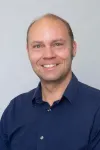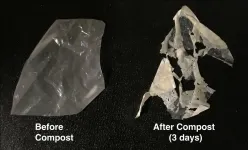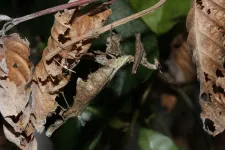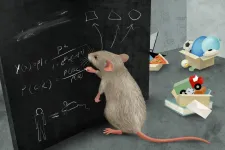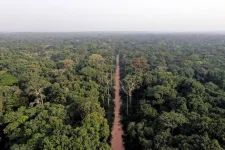(Press-News.org) A fire in Central Park seems to appear as a smoke plume and a line of flames in a satellite image. Colorful lights on Diwali night in India, seen from space, seem to show widespread fireworks activity.
Both images exemplify what a new University of Washington-led study calls "location spoofing." The photos -- created by different people, for different purposes -- are fake but look like genuine images of real places. And with the more sophisticated AI technologies available today, researchers warn that such "deepfake geography" could become a growing problem.
So, using satellite photos of three cities and drawing upon methods used to manipulate video and audio files, a team of researchers set out to identify new ways of detecting fake satellite photos, warn of the dangers of falsified geospatial data and call for a system of geographic fact-checking.
"This isn't just Photoshopping things. It's making data look uncannily realistic," said Bo Zhao, assistant professor of geography at the UW and lead author of the study, which published April 21 in the journal Cartography and Geographic Information Science. "The techniques are already there. We're just trying to expose the possibility of using the same techniques, and of the need to develop a coping strategy for it."
As Zhao and his co-authors point out, fake locations and other inaccuracies have been part of mapmaking since ancient times. That's due in part to the very nature of translating real-life locations to map form, as no map can capture a place exactly as it is. But some inaccuracies in maps are spoofs created by the mapmakers. The term "paper towns" describes discreetly placed fake cities, mountains, rivers or other features on a map to prevent copyright infringement. On the more lighthearted end of the spectrum, an official Michigan Department of Transportation highway map in the 1970s included the fictional cities of "Beatosu and "Goblu," a play on "Beat OSU" and "Go Blue," because the then-head of the department wanted to give a shoutout to his alma mater while protecting the copyright of the map.
But with the prevalence of geographic information systems, Google Earth and other satellite imaging systems, location spoofing involves far greater sophistication, researchers say, and carries with it more risks. In 2019, the director of the National Geospatial Intelligence Agency, the organization charged with supplying maps and analyzing satellite images for the U.S. Department of Defense, implied that AI-manipulated satellite images can be a severe national security threat.
To study how satellite images can be faked, Zhao and his team turned to an AI framework that has been used in manipulating other types of digital files. When applied to the field of mapping, the algorithm essentially learns the characteristics of satellite images from an urban area, then generates a deepfake image by feeding the characteristics of the learned satellite image characteristics onto a different base map -- similar to how popular image filters can map the features of a human face onto a cat.
Next, the researchers combined maps and satellite images from three cities -- Tacoma, Seattle and Beijing -- to compare features and create new images of one city, drawn from the characteristics of the other two. They designated Tacoma their "base map" city and then explored how geographic features and urban structures of Seattle (similar in topography and land use) and Beijing (different in both) could be incorporated to produce deepfake images of Tacoma.
In the example below, a Tacoma neighborhood is shown in mapping software (top left) and in a satellite image (top right). The subsequent deep fake satellite images of the same neighborhood reflect the visual patterns of Seattle and Beijing. Low-rise buildings and greenery mark the "Seattle-ized" version of Tacoma on the bottom left, while Beijing's taller buildings, which AI matched to the building structures in the Tacoma image, cast shadows -- hence the dark appearance of the structures in the image on the bottom right. Yet in both, the road networks and building locations are similar.
The untrained eye may have difficulty detecting the differences between real and fake, the researchers point out. A casual viewer might attribute the colors and shadows simply to poor image quality. To try to identify a "fake," researchers homed in on more technical aspects of image processing, such as color histograms and frequency and spatial domains.
Some simulated satellite imagery can serve a purpose, Zhao said, especially when representing geographic areas over periods of time to, say, understand urban sprawl or climate change. There may be a location for which there are no images for a certain period of time in the past, or in forecasting the future, so creating new images based on existing ones -- and clearly identifying them as simulations -- could fill in the gaps and help provide perspective.
The study's goal was not to show that geospatial data can be falsified, Zhao said. Rather, the authors hope to learn how to detect fake images so that geographers can begin to develop the data literacy tools, similar to today's fact-checking services, for public benefit.
"As technology continues to evolve, this study aims to encourage more holistic understanding of geographic data and information, so that we can demystify the question of absolute reliability of satellite images or other geospatial data," Zhao said. "We also want to develop more future-oriented thinking in order to take countermeasures such as fact-checking when necessary," he said.
Co-authors on the study were Yifan Sun, a graduate student in the UW Department of Geography; Shaozeng Zhang and Chunxue Xu of Oregon State University; and Chengbin Deng of Binghamton University.
For more information, contact Zhao at zhaobo@uw.edu.
A growing problem of 'deepfake geography': How AI falsifies satellite images
2021-04-21
ELSE PRESS RELEASES FROM THIS DATE:
A "finger phantom" to train treatment of trigger finger using ultrasound guidance
2021-04-21
BIRMINGHAM, Ala. - Treatment of an injured or diseased joint may require precise insertion of a syringe needle -- musculoskeletal sonography can help guide clinicians as they drain fluid from arthritic knees or inject corticosteroids into trigger fingers. However, there is a need for training simulators that allow practice on an inert model, before attempting treatment on a patient.
For ultrasound, such simulation trainers are called phantoms.
Researchers at the University of Alabama at Birmingham and University of South Carolina have now made a 3D-printed ...
Aerial photos uncover an invisible fault in Chinese City
2021-04-21
Decades-old aerial photos of Yudong District, Datong City in Shanxi Province, Northern China have helped researchers in their search for a fault hidden underneath the city's buildings and cement roads, researchers said at the Seismological Society of America (SSA)'s 2021 Annual Meeting.
Analyzing these photos from the 1960s and 1970s allowed Junjie Ren and colleagues to reconstruct a digital elevation model along the Shuiyu fault, helping them identify the fault trace as it passes through Datong City.
Trenching along the revealed fault trace found evidence of ...
Researchers share strategies for making geosciences more inclusive
2021-04-21
Concrete efforts to bring racial equity to the geosciences are receiving significant attention in the wake of new grassroots efforts and increased awareness of social justice issues in 2020, speakers said at the Seismological Society of America (SSA)'s 2021 Annual Meeting.
Last year's Black in Geoscience Week, for instance, began as a grassroots movement to increase representation and raise visibility among Black researchers, as well as to foster networks and connections across the world, said Louisa Brotherson, a leader of the Black in Geoscience group.
The need for community and awareness ...
Pepper the robot talks to itself to improve its interactions with people
2021-04-21
Ever wondered why your virtual home assistant doesn't understand your questions? Or why your navigation app took you on the side street instead of the highway? In a study published April 21st in the journal iScience, Italian researchers designed a robot that "thinks out loud" so that users can hear its thought process and better understand the robot's motivations and decisions.
"If you were able to hear what the robots are thinking, then the robot might be more trustworthy," says co-author Antonio Chella, describing first author Arianna Pipitone's idea that launched the study at the University of Palermo. "The robots will be easier to understand for ...
Jane Austen quote encoded in a polymer
2021-04-21
Using a novel molecular-data-storage technique, researchers at the University of Texas at Austin have encoded a quote from Jane Austen's classic novel Mansfield Park in a series of oligomers, which a third party could read back without prior knowledge of the structures that encoded the passage. The findings, published April 21st in the journal Cell Reports Physical Science, illustrate a method to encode data that allows for greater information density than DNA-based approaches and that relies on urethane-like plastics--highly accessible and structurally modifiable chemical feedstocks--instead of nucleic acids.
"This work is another step toward the long-term goal of using synthetic sequence-defined polymers for information storage," says Eric Anslyn, a chemistry ...
New process makes 'biodegradable' plastics truly compostable
2021-04-21
Biodegradable plastics have been advertised as one solution to the plastic pollution problem bedeviling the world, but today's "compostable" plastic bags, utensils and cup lids don't break down during typical composting and contaminate other recyclable plastics, creating headaches for recyclers. Most compostable plastics, made primarily of the polyester known as polylactic acid, or PLA, end up in landfills and last as long as forever plastics.
University of California, Berkeley, scientists have now invented a way to make these compostable plastics break down more easily, with just heat and water, within a few weeks, solving a problem that has flummoxed the plastics industry and environmentalists.
"People are now prepared to move into biodegradable polymers for single-use ...
Dating in a jungle: Female praying mantises jut out weird pheromone gland to attract mates
2021-04-21
It isn't only myriads of currently unknown species that await discovery in the Amazon rainforests. As a new study by German scientists at the Ruhr-University (Bochum) and the Bavarian State Collection of Zoology (Munich), published in the open-access peer-reviewed scientific Journal of Orthoptera Research, concludes, it seems that so do plenty of unusual behaviours.
"When I saw the maggot-like structures peeking out from the back of the praying mantis and then withdrew, I immediately thought of parasites that eat the animal from the inside, because that is not really uncommon in insects," says Frank Glaw, a reptile and amphibian expert from the Bavarian State Collection of Zoology, who discovered ...
Simplifying our world
2021-04-21
Categorization is the brain's tool to organize nearly everything we encounter in our daily lives. Grouping information into categories simplifies our complex world and helps us to react quickly and effectively to new experiences. Scientists at the Max Planck Institute of Neurobiology have now shown that also mice categorize surprisingly well. The researchers identified neurons encoding learned categories and thereby demonstrated how abstract information is represented at the neuronal level.
A toddler is looking at a new picture book. Suddenly it points to an illustration and shouts 'chair'. The kid made the right call, but that does not seem particularly noteworthy to us. We recognize all kinds of chairs as 'chair' without any difficulty. ...
Central African forests are unequally vulnerable to global change
2021-04-21
Central Africa is home to the world's second-largest area of dense tropical rainforest. This major reservoir of biodiversity stretches out over five main countries: Cameroon, Gabon, the Republic of Congo, the Democratic Republic of Congo and the Central African Republic. It provides numerous ecosystem services, such as regulating exchange cycles between the earth and the atmosphere, and helps to ensure food supply for local populations. Due to the threats from climate change and demographic pressure expected in Africa by the end of the 21st century, the protection and sustainable management of these forests is a challenge for policy ...
Climate 'tipping points' need not be the end of the world
2021-04-21
The disastrous consequences of climate "tipping points" could be averted if global warming was reversed quickly enough, new research suggests.
Once triggered, tipping points may lead to abrupt changes such as the dieback of the Amazon rainforest or melting of major ice sheets.
Until now, crossing these thresholds has been assumed to be a point of no return, but the new study - published in the journal Nature - concludes that thresholds could be "temporarily exceeded" without prompting permanent shifts.
The research team, from the University of Exeter and the UK Centre for Ecology and Hydrology (UKCEH), say the time available to act would depend on the level ...

